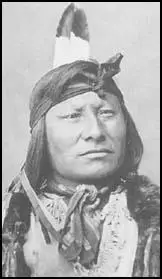Rain in the Face

Rain in the Face, a member of the Hunkpapa Sioux, was born near Cheyenne River, North Dakota, in 1835. At the age of ten he took part in the war with the Gros Ventres. One day he took part in a battle during a heavy rain storm. At the end of the day his face was streaked with war paint. As a result he was given the name Rain in the Face.
On 21st December, 1866, Captain W. J. Fetterman and an army column of 80 men, were involved in protecting a team taking wood to Fort Phil Kearny. Although under orders not to "engage or pursue Indians" Fetterman gave the orders to attack a group of Sioux warriors. The warriors ran away and drew the soldiers into a clearing surrounded by a much larger force. All the soldiers were killed in what became known as the Fetterman Massacre. Rain in the Face was one of the warriors who participated in this massacre.
In August 1873, General George A. Custer was involved in protecting a group of railroad surveyors. The group were attacked by a Sioux war party near the mouth of Tongue River. During the raid two of the surveyors were killed. Later, Charley Reynolds, an Indian scout, told Custer that Rain in the Face had led the attack at Tongue River. Rain in the Face was living on the Standing Rock Reservation at the time and so Custer had him arrested. Custer forced Rain in the Face to confess but before he could appear in court he managed to escape.
In December, 1875 the Commissioner of Indian Affairs directed all Sioux bands to enter reservations by the end of January 1876. Sitting Bull, now a medicine man and spiritual leader of his people, refused to leave his hunting grounds. Rain in the Face and Crazy Horse agreed and led their warriors north to join up with Sitting Bull.
In June 1876 Sitting Bull subjected himself to a sun dance. This ritual included fasting and self-torture. During the sun dance Sitting Bull saw a vision of a large number of white soldiers falling from the sky upside down. As a result of this vision he predicted that his people were about to enjoy a great victory.
On 17th June 1876, General George Crook and about 1,000 troops, supported by 300 Crow and Shoshone, fought against 1,500 members of the Sioux and Cheyenne tribes. The battle at Rosebud Creek lasted for over six hours. This was the first time that Native Americans had united together to fight in such large numbers.
General George A. Custer and 655 men were sent out to locate the villages of the Sioux and Cheyenne involved in the battle at Rosebud Creek. An encampment was discovered on the 25th June. It was estimated that it contained about 10,000 men, women and children. Custer assumed the numbers were much less than that and instead of waiting for the main army under General Alfred Terry to arrive, he decided to attack the encampment straight away.
Custer divided his men into three groups. Captain Frederick Benteen was ordered to explore a range of hills five miles from the village. Major Marcus Reno was to attack the encampment from the upper end whereas Custer decided to strike further downstream.
Reno soon discovered he was outnumbered and retreated to the river. He was later joined by Benteen and his men. Custer continued his attack but was easily defeated by about 4,000 warriors. At the battle of the Little Bighorn Custer and all his 264 men were killed. The soldiers under Reno and Benteen were also attacked and 47 of them were killed before they were rescued by the arrival of General Alfred Terry and his army. It was claimed afterwards that Custer had been killed by his old enemy, Rain in the Face. However, there is no hard evidence to suggest that this is true.
The U.S. army now responded by increasing the number of the soldiers in the area. As a result Rain in the Face and Sitting Bull fled to Canada. Rain in the Face remained there until 1880 when he decided to surrender to the American authorities at Fort Koegh, Montana.
Rain in the Face died at the Standing Rock Reservation on 14th September, 1905.
